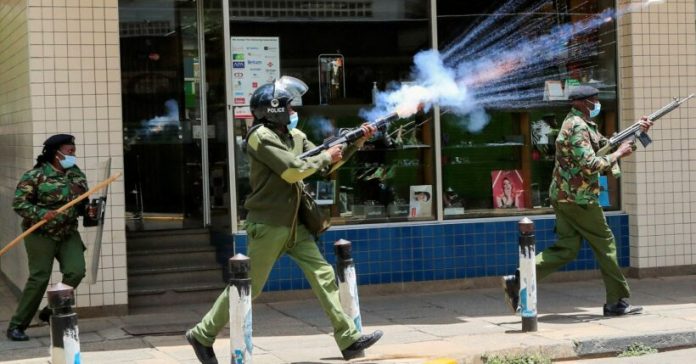Kenya is once again at the crossroads of protest and pain. A recent wave of public demonstrations has drawn global attention to the country’s deep-rooted issues of police brutality, an ongoing crisis that has claimed lives, crushed dissent, and left families grieving with few answers.
The tipping point? A brutal and public shooting that has shaken the conscience of a nation.
On June 17, 2025, 22-year-old Boniface Kariuki was selling face masks in Nairobi when he was shot at point-blank range by a police officer during protests. The horrifying incident was captured on camera, showing Kariuki holding packets of masks as a masked officer aimed and fired a shotgun at close range.
Kariuki was not a protester. He was not armed. He was simply trying to make a living.
He now lies in intensive care at Kenyatta National Hospital. His father’s words echo the pain of many Kenyans:
“He was selling masks, it’s not that he is a criminal.”
This act of excessive force has reignited outrage and renewed demands for urgent reform within Kenya’s law enforcement system.
The shooting occurred during ongoing protests sparked by the suspicious death of political blogger Albert Ojwang, who died in police custody after criticizing Deputy Inspector General of Police Eliud Lagat.
Initially dismissed by the state as a suicide, an independent autopsy later confirmed signs of blunt force trauma, causing a public uproar and exposing the continued abuse of power by police forces. The state has since apologized, and arrests have been made including officers believed to be involved in both Ojwang’s and Kariuki’s cases.
These incidents are not isolated. Over the past two years, Kenya has seen a disturbing pattern of state-sanctioned violence. During the 2024 Finance Bill Protests at least 19 protesters were killed in Nairobi alone. Police deployed live bullets, tear gas, and water cannons on unarmed demonstrators.
From mid-2023 to the end of 2024, more than 60 people were killed by police during the Gen Z led protests. The Kenya National Commission on Human Rights documented 82 cases of enforced disappearances during this period.
Journalists have not been spared from this brutality either, they have been tear-gassed, beaten, and unlawfully detained while covering protests. Photojournalist Justine Ondieki was badly injured, and reporter Catherine Wanjeri was struck with a tear-gas canister fired at close range.
Despite repeated calls from rights organizations and the international community, few officers have faced prosecution. Most cases end in silence.
Public anger is mounting, and civil society is no longer willing to accept half-measures. Human rights groups, including Amnesty International and the Independent Policing Oversight Authority (IPOA), have called for; independent, public inquiries into all deaths and shootings by police, immediate legal action against those responsible for human rights abuses, implementation of new public-order policing standards aligned with international human rights laws and safe and lawful conditions for civic participation and press freedom.
President William Ruto has publicly condemned police misconduct, and arrests have been made. But critics argue that real accountability must go beyond symbolism.
Without structural reform, Kenya risks further descent into state violence and fear. The public shooting of Boniface Kariuki, an innocent vendor simply trying to survive could have been prevented. His blood, like that of many others before him, should not have been spilled in vain.
This moment demands more than apologies. It demands justice, reform, and the political courage to stand against a culture of impunity that has plagued Kenya’s police for decades.


